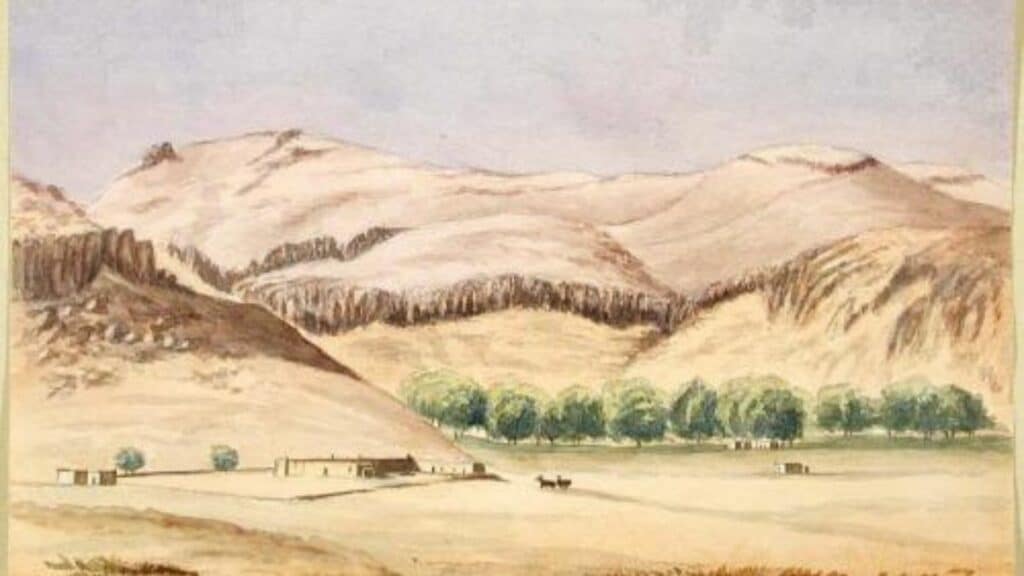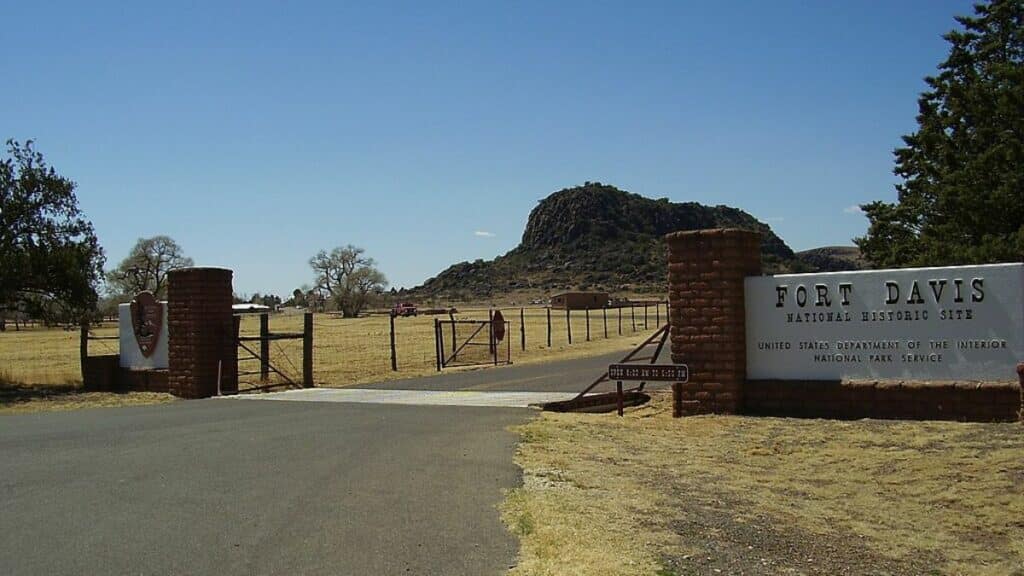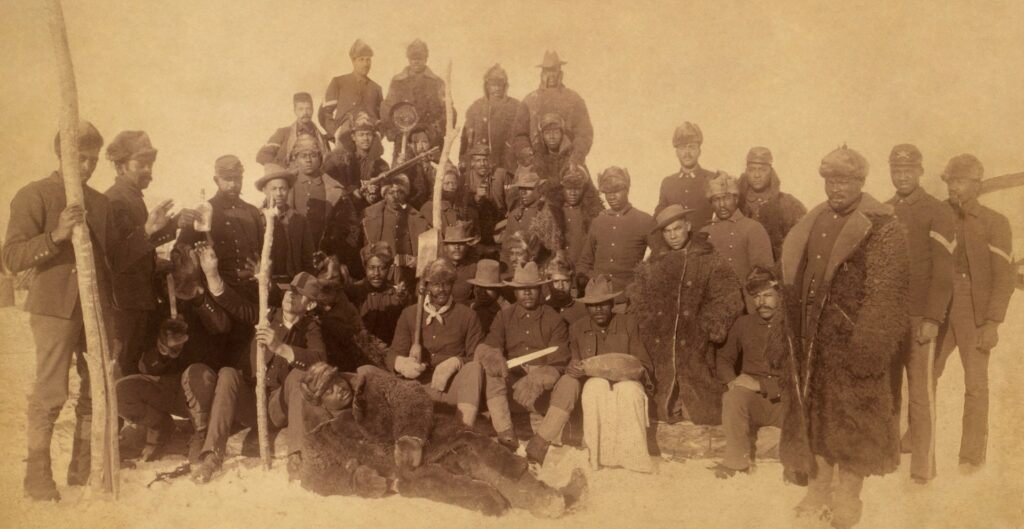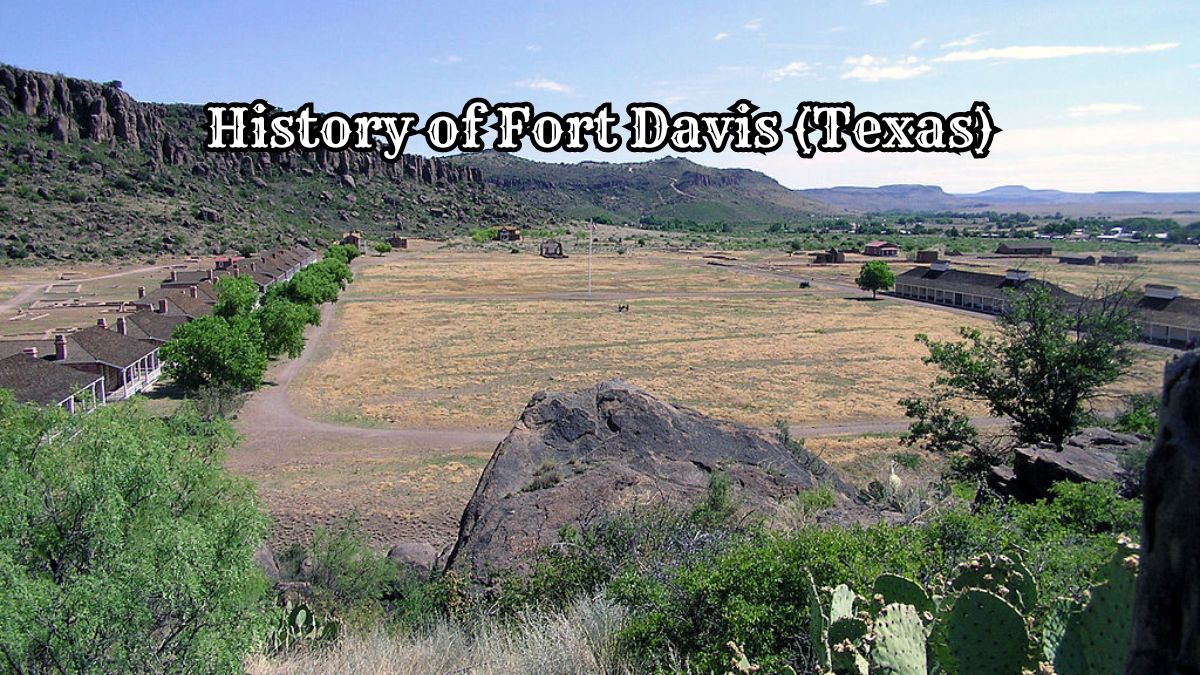Fort Davis, Texas, established in 1854, is significant in American history. Initially protecting emigrants, mail coaches, and freight wagons along the San Antonio-El Paso Road, it was named after Jefferson Davis, the U.S. Secretary of War.
The fort’s strategic location in the Davis Mountains was crucial for defending against Native American attacks.
During the Civil War, it was temporarily abandoned, only to be reoccupied in 1867 by Buffalo Soldiers, who played a vital role in its history.
Today, Fort Davis is a National Historic Site, preserving its legacy through well-preserved ruins, restored buildings, and educational programs.
History of Fort Davis (Texas)

Fort Davis, Texas, established in 1854, was a vital military post in the Davis Mountains. It was initially used to protect emigrants, mail coaches, and freight wagons traveling the Trans-Pecos portion of the San Antonio-El Paso Road.
The fort was named after Jefferson Davis, the U.S. Secretary of War and later President of the Confederate States during the Civil War. It was critical in defending settlers and travelers against Native American attacks.
The fort was abandoned in 1861 during the Civil War. The U.S. Army reoccupied it in 1867. The garrison was primarily composed of Black soldiers, known as Buffalo Soldiers, who contributed significantly to the fort’s history and legacy.
Fort Davis is now a National Historic Site. It showcases well-preserved ruins, restored buildings, and exhibits, and it stands as a historical reminder of the U.S. military’s efforts in Texas during the late 19th century.
Visitors can explore barracks, officers’ quarters, and a hospital. The site provides interpretive programs and living history demonstrations, offering a glimpse into the lives of soldiers and civilians who lived there.
This historical background underlines the fort’s impact on the region’s development and the broader narrative of Texas history.
Strategic Importance and Military Significance

Fort Davis was critical in protecting travelers and securing West Texas during key historical events, notably on the San Antonio-El Paso Road and during the Civil War.
San Antonio-El Paso Road and West Texas Security
Fort Davis was strategically placed along the San Antonio-El Paso Road, a crucial route for settlers, mail, and military supplies. This location made the fort vital for defending against raids by Apache and Comanche tribes.
The presence of soldiers provided much-needed security for travelers and settlers moving westward.
The fort’s position also facilitated surveillance along the route, ensuring uninterrupted trade and communication between San Antonio and El Paso.
The rough terrain and vast distances of the Southwest magnified the importance of having a military post like Fort Davis to serve as a secure base of operations.
The Role During the Civil War
During the Civil War, Fort Davis initially fell under Confederate control. Its strategic location made it a valuable asset for protecting the Confederate frontier against Union forces and hostile Native American tribes.
The Confederate forces maintained operations at the fort to secure the border with Mexico.
However, by mid-1862, Union forces recaptured Fort Davis, recognizing its importance in maintaining control over West Texas.
The U.S. Army continued to use the fort to protect settlers from Apache attacks and to enforce order in the region. Its role during the Civil War underscored Fort Davis’s significance in the military landscape of the Southwest.
Fort Davis and the Protection of Emigrants & Mail

Fort Davis, nestled in the Davis Mountains, was pivotal in safeguarding emigrants and maintaining communication lines through mail coaches. The presence of Buffalo Soldiers and experienced officers ensured a secure environment.
Emigrant Travel and Defense
Fort Davis was essential in protecting emigrant pioneers traveling through the West. The region posed multiple threats, including hostile encounters and natural challenges.
Stationed troops, including Buffalo Soldiers, offered necessary defense support to emigrants.
Units like the 9th and 10th Cavalry Regiments were crucial. These groups, often led by West Point-trained officers, carried out patrols and escorts.
This ensured a safer journey for those moving across the harsh terrain of the Davis Mountains. Regular patrols effectively deterred potential threats.
Mail Coaches and Communication Lines
Mail coaches were vital for maintaining communication in remote areas. Fort Davis served as a strategic point on the San Antonio-El Paso mail route, ensuring the uninterrupted flow of information.
This was vital for both civilian and military correspondence.
The defense of mail coaches was a priority.
Soldiers at Fort Davis would often accompany these coaches, protecting them against bandits and other threats.
The coordinated effort between different units ensured that valuable communication lines remained open, crucial for the functioning of settlements and military operations.
Buffalo Soldiers and Their Legacy

Buffalo Soldiers played a significant role at Fort Davis, contributing to the defense and development of the region. They interacted with local tribes and made notable achievements.
African American Troops at Fort Davis
African American soldiers served at Fort Davis from 1867 to 1885. These enlisted men were known as Buffalo Soldiers in the 9th and 10th Cavalry and 24th and 25th Infantry regiments.
Tasked with protecting settlers, mail routes, and the construction of infrastructure, they often faced challenging conditions and hostile engagements with Apache tribes, including battles against leaders like Victorio.
Service at Fort Davis helped these soldiers gain respect and recognition.
Their presence and efforts significantly contributed to the U.S. Army’s overall success in the region and aided Texas’s peaceful settlement and economic development.
Prominent Figures: Henry O. Flipper and Others
Henry O. Flipper was the first African American to graduate from West Point and served at Fort Davis starting in 1880. As a second lieutenant in the 10th Cavalry, he handled engineering projects such as constructing roads and ditches.
Despite facing racial prejudice and court-martial under controversial circumstances, Flipper’s legacy endures.
Other notable figures include Sergeant Emanuel Stance of the 9th Cavalry, a Medal of Honor recipient for his bravery in engagements with Apache warriors.
Their courage and contributions have left a lasting impact on the honor and tradition of African-American military service, recognized today by the National Park System and in the historical memory of Jeff Davis County.
Native American Relations and Conflicts
Fort Davis experienced significant interactions with Native American tribes, primarily the Apache and Comanche. These engagements were marked by cooperation and conflict, often leading to military campaigns and skirmishes.
The Apache and Comanche Presence
The Apache and Comanche held extensive territories around Fort Davis, utilizing the land for hunting and trade. These tribes were known for their resilient and adaptive lifestyles. The Kiowa also had occasional interactions with the region.
Apache bands, such as the Mescalero and Lipan, roamed the area, which was strategically important for their way of life. The Comanche, renowned horsemen, dominated the Southern Plains, making them formidable opponents and allies.
Campaigns and Skirmishes
Military campaigns often included skirmishes with Native American tribes. These conflicts were critical in the Indian Wars, involving notable figures like General Wesley Merritt.
His engagements included aggressive tactics to subdue and relocate the tribes.
Efforts to protect settlers and maintain control led to numerous battles.
Troops stationed at Fort Davis participated in expeditions that aimed to appease Native resistance, but these operations frequently resulted in prolonged and bloody conflicts.
Preservation and Museum Development
Efforts to preserve Fort Davis and develop its museum were integral to its recognition as a significant historical site.
Key milestones included its designation as a National Historic Site and the creation of various educational programs and exhibits.
Becoming a National Historic Site
Fort Davis, set along Limpia Creek in Texas, was designated a National Historic Site in 1961 through congressional action. This significant move aimed to preserve and maintain the fort’s rich history and provide resources for its restoration.
The National Park Service oversees the site, ensuring the historical integrity of the buildings and landscape.
Fort Davis became one of the best-preserved examples of a U.S. Army post in the southwestern United States. The designation recognized the fort for its role in the Indian Wars and its importance in the settlement of the West.
The effort to preserve Fort Davis also involved extensive research and documentation to restore the buildings to their historical state accurately.
Educational Programs and Exhibitions
Fort Davis’s museum development has focused on creating educational experiences for visitors of all ages.
The National Park Service has implemented several programs, including guided tours and living history demonstrations, to bring the fort’s story to life.
Exhibits at the museum include artifacts, photographs, and documents that record the daily life of soldiers and families stationed at the fort.
Special programs, such as the Junior Ranger Program, engage younger visitors and provide interactive ways to learn about the fort’s history and significance.
Educational outreach programs are also aimed at schools and community groups in Texas and nearby New Mexico to foster a deeper appreciation of the historical site.
These initiatives ensure that Fort Davis remains a preserved landmark and a vibrant educational resource.
Daily Life at the Fort
At Fort Davis, life revolved around military duties, facilities maintenance, and ensuring the health of the garrison. The structure of daily activities was rigid, influenced by specific roles and responsibilities.
Military Structure and Garrison Activities
Fort Davis housed various United States Armed Forces units, including infantry and cavalry. Between 1867 and 1885, officers and enlisted men worked together to protect the Trans-Pecos region.
The core responsibilities were daily military drills, inspections, and sentry duties. Officers held command and administrative roles, while enlisted men managed routine tasks and training exercises.
Buildings and Facilities
The fort featured several essential buildings, including barracks for enlisted men, quarters for officers, a hospital, and various support structures.
The hospital was a vital facility, addressing the garrison’s and surrounding settlements’ medical needs. Freight wagons delivered supplies to maintain these buildings, ensuring the continued development and functionality of the fort.
Health and Medical Care
Health and medical care at Fort Davis were centered around the hospital, staffed by trained medical personnel.
Common illnesses and injuries were prevalent due to harsh living conditions and frequent military engagements.
Medical staff provided treatments, conducted surgeries, and implemented preventative measures to protect the garrison’s health. Proper medical care was crucial for maintaining the morale and efficiency of the Frontier Army.
Historical Context
Fort Davis, Texas, served strategic and protective roles during its active years. Understanding its timeline and the broader military and political environment provides a clearer picture of its significance.
Chronology: 1854 to 1891
Fort Davis was established in 1854 by the United States Army. Named after then-Secretary of War Jefferson Davis, it aimed to protect settlers, mail coaches, and travelers on the Chihuahua Trail.
The fort was crucial in safeguarding the western expansion routes and maintaining peace with the local Native American tribes.
The fort saw intermittent closure, including during the Civil War when Confederate troops temporarily took control. Post-war, it was reoccupied by Federal forces in 1867.
Over the next two decades, soldiers stationed at Fort Davis consistently worked to secure the frontier, confront Apache and Comanche groups, and ensure the safety of those traversing the area.
Explore More: 10 Historic Forts in Texas: Exploring a Rich Military Heritage
Contemporary Significance and Tourism
Today, Fort Davis, Texas, thrives as a destination offering insights into military history and recreational opportunities. Visitors can enjoy the fort’s history while enjoying its natural surroundings.
Visitation and Engagement
Fort Davis National Historic Site attracts diverse visitors, from history enthusiasts to families seeking educational opportunities. The site, managed by the National Park Service, provides interpretative programs explaining the roles of the Tenth Cavalry and Twenty-fifth Infantry.
Exhibits:
- Museum displays
- Historic buildings
- Artifact collections
Programs:
- Guided tours
- Reenactments
- Educational workshops
Children’s programs and ranger-led activities enhance engagement, making history accessible to all ages. The visitor center offers resources and information to comprehensively understand the fort’s historical context.
Climate and Natural Resources
Fort Davis enjoys a semi-arid climate, with warm summers and mild winters, making it suitable for year-round visitation. The area is part of the Chihuahuan Desert, which provides a unique setting rich in biodiversity.
Weather Summary:
- Summer: Highs around 85°F (29°C)
- Winter: Lows around 30°F (-1°C)
Natural Features:
- Davis Mountains
- Diverse flora and fauna
- Starry night skies
The clear skies and minimal light pollution make Fort Davis a prime spot for stargazing, particularly at the nearby McDonald Observatory. This setting contributes to its appeal for nature lovers and outdoor enthusiasts.
Camping and Outdoor Activities
Fort Davis serves as a gateway to numerous outdoor activities. The Davis Mountains provide opportunities for hiking, camping, and wildlife observation.
Many visitors choose to camp at Davis Mountains State Park, which offers a range of facilities.
Camping Options:
- Tent sites
- RV hookups
- Primitive campsites
Recreational Activities:
- Hiking trails
- Bird watching
- Picnicking areas
Nearby attractions, including the charming town of Marfa, add to the variety of experiences available.
Fort Davis is a cornerstone of historical education and outdoor recreation, attracting visitors looking for an enriching and adventurous experience.
Explore More: Army Forts in Texas
Academic Research and Bibliography
Numerous academic studies and publications have detailed Fort Davis’s rich military and social history.
Notable Publications and Studies
Several scholars have made significant contributions to the history of Fort Davis.
One of the foremost experts is Robert M. Utley, who authored major studies documenting the fort’s role as a U.S. Army post.
His work includes detailed accounts of the fort’s construction, military operations, and unique aspects, such as the participation of African-American soldiers.
Another important source is the Special Report on Fort Davis, prepared by the University of Texas at Austin.
This comprehensive report provides insights into the fort’s various eras of use, its architectural evolution, and its strategic importance.
The Handbook of Texas Online Resource
The Handbook of Texas Online is an essential resource for anyone researching Fort Davis. Managed by the Texas State Historical Association, it offers extensive entries on the fort’s history, key figures, and events.
The online resource includes bibliographical references, making it easier for researchers to find additional primary and secondary sources.
It also assists in understanding the broader historical context in which Fort Davis operated, including its role in westward expansion and its interactions with local communities.

Cory is a website owner and content creator who enjoys fishing, history, coin collecting, and sports, among other hobbies. He is a husband and father of four.
Romans 15:4 For whatever was written in former days was written for our instruction, that through endurance and through the encouragement of the Scriptures we might have hope.

